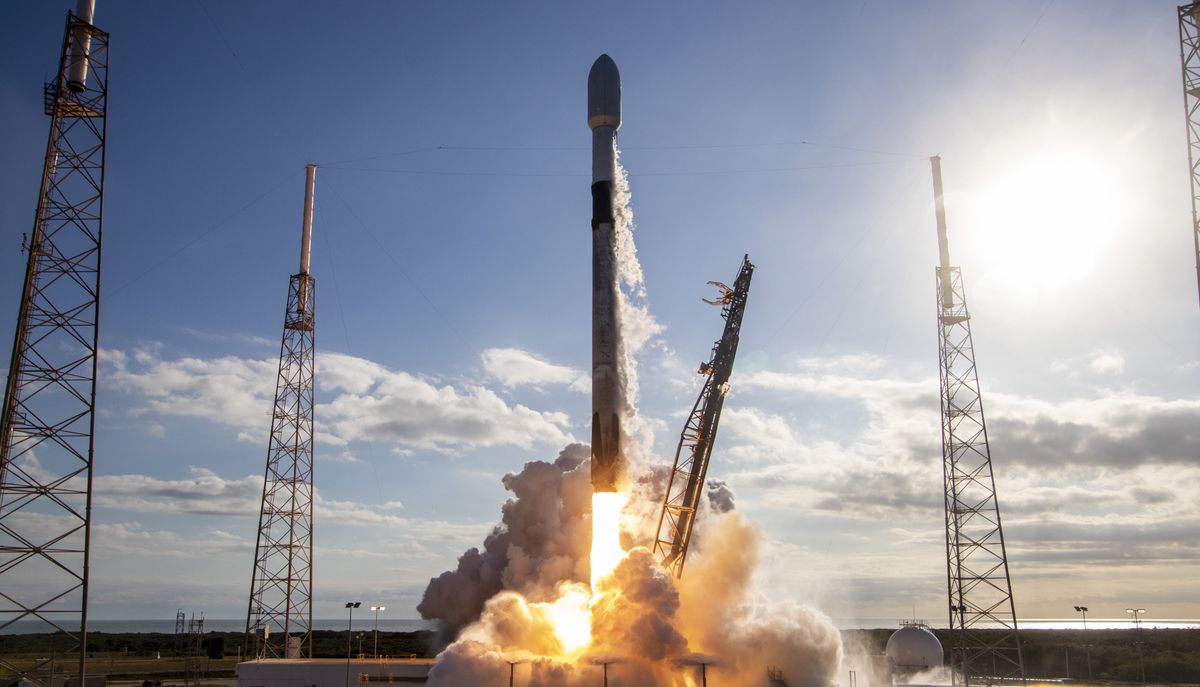
UPDATE: SpaceX's Falcon 9 rocket experienced an abort at the T-0 mark for today's launch due to an engine power issue. Read our full story.
Original story
CAPE CANAVERAL, Fla. — The private spaceflight company SpaceX will launch 60 new Starlink satellites to join its ever-growing broadband internet megaconstellation today (March 15) and you can watch it live online.
A SpaceX Falcon 9 rocket will launch the Starlink mission from Pad 39A at NASA's Kennedy Space Center in Florida. Liftoff is scheduled for 9:22 a.m. EST (1322 GMT).
You can watch SpaceX's Starlink launch webcast here and on the Space.com homepage, courtesy of SpaceX, beginning about 15 minutes before liftoff. You'll also be able to watch the launch directly from SpaceX here.
Study: Satellite megaconstellations will mar astronomers' view of heavens
This is SpaceX's sixth launch of the year and the sixth Starlink launch to date. The mission will star a veteran Falcon 9 rocket that will do what no other Falcon has done before: launch and land five times. The booster, dubbed B1048.5, previously launched a bevy of satellites including part of the Iridium NEXT constellations, an Israeli lunar lander a communications satellites for Argentina and Indonesia, and a previous Starlink mission.
This is a major milestone for SpaceX. The upgraded version of their workhorse was introduced in 2018, launching the first communications satellite for Bangladesh. Company founder and CEO, Elon Musk said that the souped up booster would be able to fly ten times with little refurbishment in between. Sunday's flight marks the first time a Falcon has reached the halfway point.
To date, four Falcons have four successful flights under their belts, but today’s booster will be the first to launch five times. However, of those four, two were not recovered and will not fly again. One was intentionally destroyed during the company’s in-flight abort test and the booster used in the latest Starlink mission before this one, it was lost after narrowly missing the drone ship.
Related: Why SpaceX's Starlink satellites caught astronomers off guard
The goal of SpaceX's Starlink project is to provide users around the world with constant, high-speed internet access. The company plans to achieve that by launching a massive constellation of broadband internet satellites.
Users on the ground would then operate a small terminal — no bigger than a laptop — to gain internet access.
As evident by the launches so far this year, the majority of SpaceX's missions in 2020 will consist of sending Starlink satellites into space. This is the fourth Starlink launch of the year, which expands the company’s fleet of internet-beaming satellites to more than 350.
SpaceX CEO and founder Elon Musk has previously stated that the company will need at least 400 Starlink satellites in orbit to offer "minor" broadband coverage, and at least 800 to provide "moderate" coverage. With this launch, they are moving closer to that goal.
Related: SpaceX launches 60 Starlink satellites, misses rocket landing
The weather is looking excellent, with only a 10% chance of weather violation, according to forecasters at the 45th Weather Squadron. Temperatures in the area are supposed to be around 70 degrees with a few scattered clouds.
The company fired up the rocket late Friday afternoon, as part of a routine prelaunch test, called a static fire test. This integral part of prelaunch procedures is crucial to ensuring that all systems are ready for launch.
Shortly after, the company tweeted that the test was a success and the launch would proceed as planned.
Static fire test of Falcon 9 complete—targeting Sunday, March 15 at 9:22 a.m. EDT, 13:22 UTC, for launch of 60 Starlink satellites from LC-39A in FloridaMarch 13, 2020
Approximately eight minutes after launch, the Falcon’s first stage will return to Earth. It’s scheduled to touch down on the deck of SpaceX’s drone ship, Of Course I Still Love You, stationed out in the Atlantic Ocean.
The company has also deployed its two fairing-catching ships: GO Ms. Tree and GO Ms. Chief in hopes of snagging the payload fairings as they fall back to Earth. The fairing used in today’s launch attempt was previously used on the first Starlink mission. (It was refurbished after gently splashing down in the ocean.)
SpaceX aims to catch and refurbish fairings to cut down on costs and reuse more of its launch hardware. Currently the company has successfully recovered 50 first stage boosters and GO Ms. Tree has made three successful fairing catches. With any luck, the company will see its first double catch today.
Visit Space.com today for complete coverage of SpaceX's Starlink launch.
Follow Amy Thompson on Twitter @astrogingersnap. Follow us on Twitter @Spacedotcom or Facebook.
"how" - Google News
March 15, 2020 at 06:33PM
https://ift.tt/3aYuc7M
SpaceX to launch next 60 Starlink internet satellites today. Here's how to watch live. - Space.com
"how" - Google News
https://ift.tt/2MfXd3I
Bagikan Berita Ini















0 Response to "SpaceX to launch next 60 Starlink internet satellites today. Here's how to watch live. - Space.com"
Post a Comment